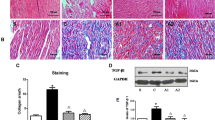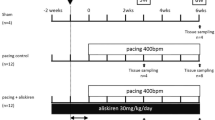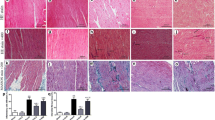Abstract
Purpose
Aliskiren inhibits the activation of the renin-angiotensin system. Here, we investigated the effects of aliskiren on chronic atrial iron remodeling in the experimental canine model of rapid atrial pacing.
Methods
Twenty-eight dogs were assigned to sham (S), control paced (C), paced + aliskiren (10 mg Kg−1 d−1, A1), and paced + aliskiren (20 mg Kg−1 d−1, A2) groups. Rapid atrial pacing at 500 bpm was maintained for 2 weeks, while group S was not paced. Levels of serum angiotensin-converting enzyme and angiotensin II after pacing were determined by ELISA. Whole-cell patch-clamp technique, western blot, and RT-PCR were applied to assess atrial ionic remodeling.
Results
The density of I CaL and I Na currents (pA/pF) was significantly lower in group C compared with group S (I CaL: −4.09 ± 1.46 vs. −6.12 ± 0.58,P < 0.05; I Na: 30.48 ± 6.08 vs. 46.31 ± 4.73, P < 0.05). However, the high dose of aliskiren elevated the density of I CaL and I Na currents compared with group C (I CaL: −6.23 ± 1.35 vs. −4.09 ± 1.46, P < 0.05; I Na: 58.62 ± 16.17 vs. 30.48 ± 6.08, P < 0.01). The relative mRNA and protein expression levels of Cav1.2 and Nav1.5α were downregulated in group C respectively (Cav1.2: 0.46 ± 0.08; Nav1.5α: 0.52 ± 0.08, P < 0.01; Cav1.2: 0.31 ± 0.03; Nav1.5α: 0.41 ± 0.04, P < 0.01;), but were upregulated by aliskiren.
Conclusions
Aliskiren has protective effects on atrial tachycardia-induced atrial ionic remodeling.




Similar content being viewed by others
References
Camm AJ, Kirchhof P, Lip GY, et al. Guidelines for management of atrial fibrillation: the task force for the management of atrial fibrillation of the european society of cardiology (ESC). Eur Heart J. 2010;31:2369–429.
Nattel S. From guidelines to bench: implications of unresolved clinical issues for basic investigations of atrial fibrillation mechanisms. Can J Cardiol. 2011;27:19–26.
Liu E, Yang S, Xu Z, Li J, Yang W, Li G. Angiotensin-(1–7) prevents atrial fibrosis and atrial fibrillation in long-term atrial tachycardia dogs. Regul Pept. 2010;162:73–8.
Liu E, Xu Z, Li J, Yang S, Yang W, Li G. Enalapril, irbesartan, and angiotensin-(1–7) prevent atrial tachycardia-induced ionic remodeling. Int J Cardiol. 2011;146:364–70.
Rogart RB, Cribbs LL, Muglia LK, Kephart DD, Kaiser MW. Molecular cloning of a putative tetrodotoxin-resistant rat heart Na+ channel isoform. Proc Natl Acad Sci U S A. 1989;86:8170–4.
Villamil A, Chrysant SG, Calhoun D, et al. Renin inhibition with aliskiren provides additive antihypertensive efficacy when used in combination with hydrochlorothiazide. J Hypertens. 2007;25:217–26.
Cohen NC. Structure-based drug design and the discovery of aliskiren (Tekturna): perseverance and creativity to overcome a R&D pipeline challenge. Chem Biol Drug Des. 2007;70:557–65.
Brown MJ. Aliskiren. Circulation. 2008;118:773–84.
Fisher ND, Jan Danser AH, Nussberger J, Dole WP, Hollenberg NK. Renal and hormonal responses to direct renin inhibition with aliskiren in healthy humans. Circulation. 2008;117:3199–205.
Stanton A. Now that we have a direct renin inhibitor, what should we do with it? Curr Hypertens Rep. 2008;10:194–200.
Feldman DL. New insights into the renoprotective actions of the rennin inhibitor aliskiren in experimental renal disease. Hypertens Res. 2010;33:279–87.
Nguyen G. The (pro)renin receptor: pathophysiological roles in cardiovascular and renal pathology. Curr Opin Nephrol Hypertens. 2007;16:129–33.
Nattel S, Li D. Ionic remodeling in the heart: pathophysiological significance and new therapeutic opportunities for atrial fibrillation. Circ Res. 2000;87:440–7.
Yue L, Feng J, Li GR, Nattel S. Transient outward and delayed rectifier currents in canine atrium: properties and role of isolation methods. Am J Physiol. 1996;270:H2157–68.
Li D, Melnyk P, Feng J, et al. Effects of experimental heart failure on atrial cellular and ionic electrophysiology. Circulation. 2000;101:2631–8.
Gramley F, Himmrich E, Mollnau H, Theis C, Hammwohner M, Goette A. Recent advances in the pharmacological treatment of cardiac arrythmias. Drugs Today (Barc). 2009;45:807–24.
Goette A, Staack T, Röcken C, et al. Increased expression of extracellular signal-regulated kinase and angiotensin-converting enzyme in human atria during atrial fibrillation. J Am Coll Cardiol. 2000;35:1669–77.
Goette A, Arndt M, Röcken C, et al. Regulation of Angiotensin II Receptor Subtypes During Atrial Fibrillation in Humans. Circulation. 2000;101:2678–81.
Kumagai K, Nakashima H, Urata H, et al. Effects of angiotensin II type 1 receptor antagonist on electrical and structural remodeling in atrial fibrillation. J Am Coll Cardiol. 2003;41:2198–203.
Zhang Y, Zhang P, Mu Y, et al. The role of renin-angiotensin system blockade therapy in the prevention of atrial Fibrillation: A meta-analysis of randomized controlled trials. Clin Pharmacol Ther. 2010;88:521–31.
Müller DN, Luft FC. Direct renin inhibition with aliskiren in hypertension and target organ damage. Clin J Am Soc Nephrol. 2006;1:221–8.
The GISSI-AF Investigators, Disertori M, Latini R, et al. Valsartan for prevention of recurrent atrial fibrillation. N Engl J Med. 2009;360:1606–17.
Nakashima H, Kumagai K. Reverse-remodeling effects of angiotensin II type 1 receptor blocker in a canine atrial fibrillation model. Circ J. 2007;71:1977–82.
Yue L, Feng J, Gaspo R, Li GR, Wang Z, Nattel S. Ionic remodeling underlying action potential changes in a canine model of atrial fibrillation. Circ Res. 1997;81:512–25.
Brundel BJ, van Gelder IC, Henning RH, et al. Gene expression of proteins influencing the calcium homeostasis in patients with persistent and paroxysmal atrial fibrillation. Cardiovasc Res. 1999;42:443–54.
Goette A, Honeycutt C, Langberg JJ. Electrical remodeling in atrial fibrillation. Time course and mechanisms. Circulation. 1996;94:2968–74.
Ausma J, Dispersyn GD, Duimel H, Thone F, Ver Donck L, Allessie MA, et al. Changes in ultrastructural calcium distribution in goat atria during atrial fibrillation. J Mol Cell Cardiol. 2000;32:355–64.
Sun H, Chartier D, Leblanc N, Nattel S. Intracellular calcium changes and tachycardia-induced contractile dysfunction in canine atrial myocytes. Cardiovasc Res. 2001;49:751–61.
Wilde AA, Brugada R. Phenotypical manifestations of mutations in the genes encoding subunits of the cardiac sodium channel. Circ Res. 2011;108:884–97.
Darbar D, Kannankeril PJ, Donahue BS, et al. Cardiac sodium channel (SCN5A) variants associated with atrial fibrillation. Circulation. 2008;117:1927–35.
Fischer R, Dechend R, Qadri F, et al. Dietary n-3 polyunsaturated fatty acids and direct renin inhibition improve electrical remodeling in a model of high human renin hypertension. Hypertension. 2008;51:540–6.
Solomon SD, Appelbaum E, Manning WJ, et al. Effect of the direct rennin inhibitor aliskiren, the angiotensin receptor blocker losartan, or both on left ventricular mass in patients with hypertension and left ventricular hypertrophy. Circulation. 2009;119:530–7.
Shang LL, Sanyal S, Pfahnl AE, et al. NF-kappaB-dependent transcriptional regulation of the cardiac scn5a sodium channel by angiotensin II. Am J Physiol Cell Physiol. 2008;294:C372–9.
Bkaily G, Sculptoreanu A, Wang S, et al. Angiotensin II-induced increase of T-type Ca2+ current and decrease of L-type Ca2+ current in heart cells. Peptides. 2005;26:1410–7.
von Lewinski D, Kockskämper J, Rübertus SU, et al. Direct pro-arrhythmogenic effects of angiotensin II can be suppressed by AT1 receptor blockade in human atrial myocardium. Eur J Heart Fail. 2008;10:1172–6.
Kumagai K, Nakashima H, Urata H, Gondo N, Arakawa K, Saku K. Effects of angiotensin II type 1 receptor antagonist on electrical and structural remodeling in atrial fibrillation. J Am Coll Cardiol. 2003;41:2197–204.
Ye Y, Qian J, Castillo AC, Perez-Polo JR, Birnbaum Y. Aliskiren and valsartan reduce myocardial AT1 receptor expression and limit myocardial infarct size in diabetic mice. Cardiovasc Drugs Ther. 2011;25:505–15.
Fraune C, Lange S, Krebs C, et al. AT1 antagonism and renin inhibition in mice: pivotal role of targeting angiotensin II in chronic kidney disease. Am J Physiol Renal Physiol. 2012;303:F1037–48.
Whaley-Connell A, Habibi J, Rehmer N, et al. Renin Inhibition and AT1R blockade improve metabolic signaling, oxidant stress and myocardial tissue remodeling. Metabolism. 2013;62:861–72.
Choi DE, Jeong JY, Lim BJ, et al. Aliskiren ameliorates renal inflammation and fibrosis induced by unilateral ureteral obstruction in mice. J Urol. 2011;186:694–701.
Acknowledgments
This work was supported by the Program of Natural Science Foundation of China (No. 81370300) and China Education Ministry Colleges and Universities Special Scientific Research Foundation for Doctoral Advisor Class (No. 20121202110004).
Author information
Authors and Affiliations
Corresponding author
Rights and permissions
About this article
Cite this article
Zhao, Z., Wang, X., Li, J. et al. Protective Effects of Aliskiren on Atrial Ionic Remodeling in a Canine Model of Rapid Atrial Pacing. Cardiovasc Drugs Ther 28, 137–143 (2014). https://doi.org/10.1007/s10557-014-6509-x
Published:
Issue Date:
DOI: https://doi.org/10.1007/s10557-014-6509-x




